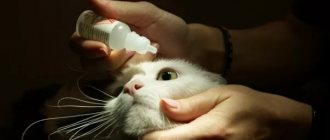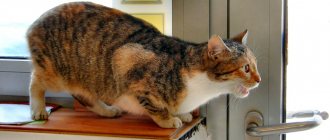Cats, like people, can suffer from various diseases, be injured or have pathologies. The animal cannot help itself, so it is important for the owner to be fully prepared and be able to help the pet in various situations. This must be done carefully, because an animal that is injured or suffering from painful sensations can become aggressive and cocky, because it does not know that they want to alleviate its condition, but it feels the additional discomfort very well.
Let's look at cases of bleeding in cats from the urethra (hematuria) and from the uterus, why they happen, and what needs to be done.
Negative reasons for discharge
The causes of intrauterine bleeding in cats can be different.:
- Inflammatory diseases, including endometritis, pyometra. The reproductive system of a pet includes the ovaries, uterus, vagina and external genitalia. They are manifested by the animal’s restlessness, the appearance of aggressiveness, and active licking of the external genitalia;
- Damage to the uterus. Accompanied by copious bleeding. There are many blood vessels on the walls of this organ;
- Oncological diseases of cats. Cancer cells suppress the general immune system, including the genitourinary system. Danger is indicated by purulent bloody discharge with an unpleasant odor. They are caused by the growth or destruction of a tumor;
- Decaying placenta. It is possible that after birth, part of the placenta will remain inside. This leads to its decomposition. As a result, blood comes from the vagina. There is a high probability of surgical intervention.
© shutterstock
Overt and hidden internal bleeding
Discharge from a pregnant cat: bloody, yellow
It is impossible to see internal bleeding in a cat. But some similar processes are manifested by certain external symptoms and are called overt internal bleeding.
Table of external symptoms of obvious internal bleeding:
| Type of obvious internal bleeding | Accompanying external symptoms |
| Esophageal | Vomiting with bright scarlet blood. |
| Gastric | Burgundy or brown clots of coagulated blood in the vomit. |
| Intestinal | Burgundy or brown clots of coagulated blood in vomit (small intestine) and/or stool with traces of dark blood or black in consistency like coffee grounds (lower intestines). |
| Pulmonary | Wet cough with bloody foam. |
| Royal | Bloody discharge from the loop. |
| Renal | Blood or traces of it in every urine sample. |
External symptom of obvious internal bleeding
Pyometra
A disease of cats that occurs when the level of progesterone in the blood increases. Leads to purulent inflammation of the uterus. Cats that have never given birth and are receiving antisex drugs to suppress estrus are susceptible.
The disease can be open or closed, depending on the open/closed cervix. The open version is characterized by purulent or bloody discharge. It is easier for the cat to tolerate due to the fact that the discharge comes out through an open lumen in the cervix. With the closed version there is no discharge. Pus and blood accumulate in the uterus. And since at an early stage, closed pyometra is asymptomatic, this will lead to intoxication, rupture of the organ and death of the cat.
Symptoms of the disease:
- deterioration of general condition;
- lack of appetite, vomiting;
- increase in abdominal volume;
- active licking of the belly.
In most cases, removal of the cat's uterus and ovaries is an effective treatment. After surgery, a course of antibiotic treatment is carried out, as well as maintenance therapy. In some cases, drug therapy is allowed. However, it is worth considering that it can lead to temporary improvement with further relapse.
Endometritis
Inflammation of the uterine mucosa. The cause is genital infections. Animals walking on the street, young cats under 3 years of age, when using hormonal drugs for estrus, an unbalanced diet, difficult childbirth, and a hereditary tendency are at risk.
© shutterstock
The disease is considered in acute or acquired form. Let's look at the symptoms. In the acquired form, symptoms are mild. The pet looks healthy in appearance, but often licks itself, so the cat’s blood from the uterus is not visible. The danger is that this form can become purulent. This is due to increased accumulation of secretions due to thickening of the uterine mucosa. The secretion is a favorable environment for the development of infections. Characterized by copious discharge and increased body temperature. Urgent medical assistance is required.
Symptoms in acute form:
- temperature increase;
- loss of appetite;
- copious discharge from the genital opening;
- often arches his back and assumes a posture for urination;
- abdominal enlargement;
- the external genitalia are inflamed.
At an early stage, antibiotics and antimicrobials are used. In case of purulent form, sterilization is carried out. To increase the body's defenses, immunomodulators are prescribed.
What to do if you find blood in your cat
Being a caring owner means, among other things, responding in a timely manner to signs of health problems in your pet. A kitten's blood is certainly one of these, and it almost certainly indicates some kind of injury or disease. This should not happen in a completely healthy animal. Therefore, to help the owners, in this article the Murkoshi team will talk about the main cases when a cat bleeds, why this happens and what needs to be done in such situations.
Why might a cat bleed?
If you notice that your cat is bleeding, try to identify the source of the bleeding. Of course, we are not talking about a situation where there is heavy bleeding - in this case, you should immediately take the cat to a veterinary clinic. So, if you find traces of blood somewhere on the fur, then perhaps there is nothing to worry too much about. Most likely, this is a minor wound caused by a curious cat being slightly injured by an object. Especially if the cat does not go outside. If the wound is small, then simply treating it with peroxide is enough.
Read more about cat wounds and first aid: How to treat cat wounds
If your cat constantly walks outside, we still recommend (just in case) to show it to the veterinarian, and then reconsider your attitude towards self-walking. There is nothing for a domestic cat to do outside, but the risk of getting lost, getting hurt or dying there is very high. Even if the cat has a small wound now, next time he may come with more serious damage. Or don't come at all.
Read more about the dangers of self-walking: What is cat self-walking and why is it dangerous?
It also happens that a cat bleeds not from a wound, but from natural orifices (mouth, nose, anus, vagina, ears). This condition is very dangerous because the causes of such bleeding are usually serious. To figure out why your cat is bleeding, you need to thoroughly examine your pet at a veterinary clinic. For example, the reason may lie in a disease of the internal organs, or in the fact that a foreign body is stuck inside, or in a tumor, or there is a problem with blood clotting. In any case, you should never make a diagnosis yourself. As you can see, there are many reasons why a cat is bleeding. It is impossible for a person without special education and work experience to understand them. And improper treatment will not only lead to the disease getting worse, but also to the fact that internal organs may stop functioning normally.
Blood in stool
It is possible that you will find blood not on the cat's body, but in the feces. Sometimes this phenomenon is not something terrible. For example, if there was little blood and this case turned out to be an isolated incident, then most likely the reason is that during defecation, hard feces scratched the mucous membrane of the rectum and damaged the anal sphincter. To prevent this from happening in the future, provide your cat with constant access to fresh water. You can also give not only dry, but also wet food of a similar class. If blood is constantly detected in the stool, then you need to consult a specialist. He will conduct an examination and identify the true cause. The problem may be caused by the following reasons:
- bacterial infection; - helminths; - allergic reaction; - polyps and tumors in the intestines; - poor blood clotting (in this case, most likely, bleeding will be found not only in the stool).
Any of these problems are extremely serious and can threaten the health and even life of the cat. And each of them requires specific treatment. Therefore, it is important to make the correct diagnosis as quickly as possible and prescribe an appropriate course of therapy.
Blood in urine
Blood in a cat's urine is called hematuria. This always indicates the presence of some disease or pathology. The difficulty is that if a cat uses a litter tray, it is often very difficult to notice blood in the urine. However, owners should be alert to changes in the color of urine or bloody spots or blood clots in the tray. In this case, you should immediately contact a veterinarian. The causes of blood in a kitten's urine can be:
1. Inflammatory processes in the kidneys, bladder or ureters. This is an extremely alarming symptom. In addition to the fact that it is simply painful for the animal to relieve itself, due to these inflammatory processes, the infection can spread throughout the body, because blood is forced through the kidneys. And if they are colonized by bacteria or viruses, then each “batch” of blood filtered by the kidneys will be infected. The most common cause associated with bladder inflammation is cystitis. Urgent medical attention is needed, including anti-inflammatory and antibacterial drugs, before the pet’s condition worsens.
2. Urolithiasis. This disease deserves special mention. When stones pass, their sharp edges injure the tissues of the urinary system - this provokes internal bleeding. If treatment is delayed, it can lead to the death of the animal. Urolithiasis often develops due to poor nutrition, so to prevent it, you should immediately provide your cat with a proper and balanced diet - super premium or holistic food that contains all the necessary vitamins and minerals. At the Murkosha shelter, we feed our charges with this very food, so they feel vigorous and healthy even in old age. We also remind you that your cat should always have access to fresh drinking water.
Read more: What to do if your cat has urolithiasis
3. Internal organ injuries and systemic diseases. The causes of hematuria can be, for example, liver and blood diseases, infectious processes in the body, and heart failure.
4. Tumor in the urinary tract. In this case, blood in the cat’s urine is accompanied by painful urination. In older animals, this may indicate the presence of advanced cancer.
5. Poisoning or side effects of medications. Do not self-medicate under any circumstances, and certainly do not give your cat human medications without consulting a veterinarian! Because of this, animals experience poisoning, accompanied by internal bleeding. Often these are kidney bleeding, which causes blood to appear from the urethra. Also, internal bleeding can be caused by various chemicals: dishwashing detergents, washing powder, perfumes, varnishes, glue, etc.
6. Helminths. Worms can cause blood in a kitten's urine if they infect the kidneys or bladder.
Read more about how to get rid of helminths: How to get rid of worms in cats?
Treatment
The best thing that owners can do if they find blood in a cat’s urine is to show it to a doctor as soon as possible, collect the urine for analysis, and then strictly adhere to the specialist’s instructions. As you can see, there are many reasons why a cat has blood (in urine, feces, on the body), and each of them requires its own treatment regimen. It is not possible to describe them all in one article. Cats are usually prescribed antibacterial and anti-inflammatory medications, and painkillers may be prescribed. The doctor may also prescribe nutritional therapy. If a cat develops dehydration due to poisoning, it is given IV drips with saline and glucose. Also, in case of poisoning, vitamin K and drugs to improve blood clotting are used. Parasitic diseases are treated with deworming. In some cases (polyps, tumors, kidney stones) surgery will be required.
Thus, a cat’s blood usually indicates problems that lie within the body. There may be many specific reasons, but they are all quite serious and require timely treatment. “Murkosha” reminds: no self-medication! If you notice blood in your cat's discharge or bleeding, seek professional help immediately! Compliance with this rule is the key to the health and long life of your pet.
Symptoms of uterine bleeding
What symptoms indicate bleeding? With hidden bleeding, the cat becomes lethargic, inactive, and has an impaired appetite. Severe shortness of breath and increased fatigue appear. The temperature on the skin of the paws is significantly lower than the body. The abdomen is dense, enlarged, the mucous membranes are pale. Symptoms increase gradually over a period of several days to several weeks.
The owner should not forget that during intrauterine bleeding, almost all the blood remains in the organ cavity. And only in isolated cases are spots on the external genitalia. Such bleeding is very dangerous because it is detected too late.
If there is obvious bleeding, the cat coughs up blood, vomits, and the stool becomes liquid with bloody streaks. Bloody discharge from the loop and blood in the urine are observed. It is important to immediately consult a doctor if the symptoms listed above are present, as well as if the bleeding continues for more than 15 minutes and the cat has significant blood loss after it stops.
© shutterstock
First aid when a cat is bleeding from the vagina prohibits any independent actions.
Postpartum complications
There are often cases when the labor period occurs with complications, the cause of which may be:
- Postpartum trauma. At this time, the cat has a bright, copious discharge, sometimes accompanied by mucous discharge with blood clots. In addition, the animal becomes restless, has heart rhythm disturbances, rapid, sometimes shallow breathing. When the bleeding continues for more than 10 minutes, if she does not undergo urgent surgery, she will die.
- Inflammatory processes of the uterus. If an infection gets into the birth canal, an inflammatory process may develop. Moreover, inflammation can occur not only at the time of childbirth, but also after it, because the uterus closes for about 10 days. During this time, inflammation may develop, the culprits of which are most often an unclean nest, a dead kitten remaining in the cat's tummy, or an incompletely released placenta. During the inflammatory process of the uterus, bleeding becomes thick and profuse, with a greenish tint. The cat's temperature rises, she is lethargic and apathetic towards kittens.
- Eclampsia is an acute condition in which calcium is washed out, leading to seizures in the form of convulsions. This phenomenon is popularly called milk fever and occurs due to a lack of calcium. As a rule, it appears in the case of multiple pregnancies and improper feeding before the birth of kittens. Mommy’s breathing and heart rate increase, and her temperature rises. She becomes restless, apathetic towards kittens, she experiences disorganization of movements, a convulsive state and increased drooling.
- Uterine prolapse. This phenomenon may occur due to sagging or hydrocele of the uterus, a large number of kittens, due to rapid birth, short umbilical cord of the fetus, due to birth without water, that is, the so-called dry birth. At this time, part of the uterus may protrude from the vulva. The cat has great difficulty going to the toilet, both small and large. She constantly pushes and arches her back. In this case, only a veterinarian can help her; most often, surgery is performed to remove the uterus.
Nature of the discharge
By the nature of the discharge, you can tell whether the cat has postpartum problems:
- Bloody discharge with a greenish tint indicates an inflammatory process of the uterus. In this case, you need to contact your veterinarian and check whether there is a dead kitten in the cat’s womb or whether the placenta has completely passed. If the animal is not given timely assistance, intoxication of the body may occur.
- Mucous discharge of a yellowish, gray tint is also a bad sign; they indicate that an inflammatory process is taking place in the uterus.
- Bloody discharge with milk indicates an inflammatory process in the genitals or genitourinary system.











